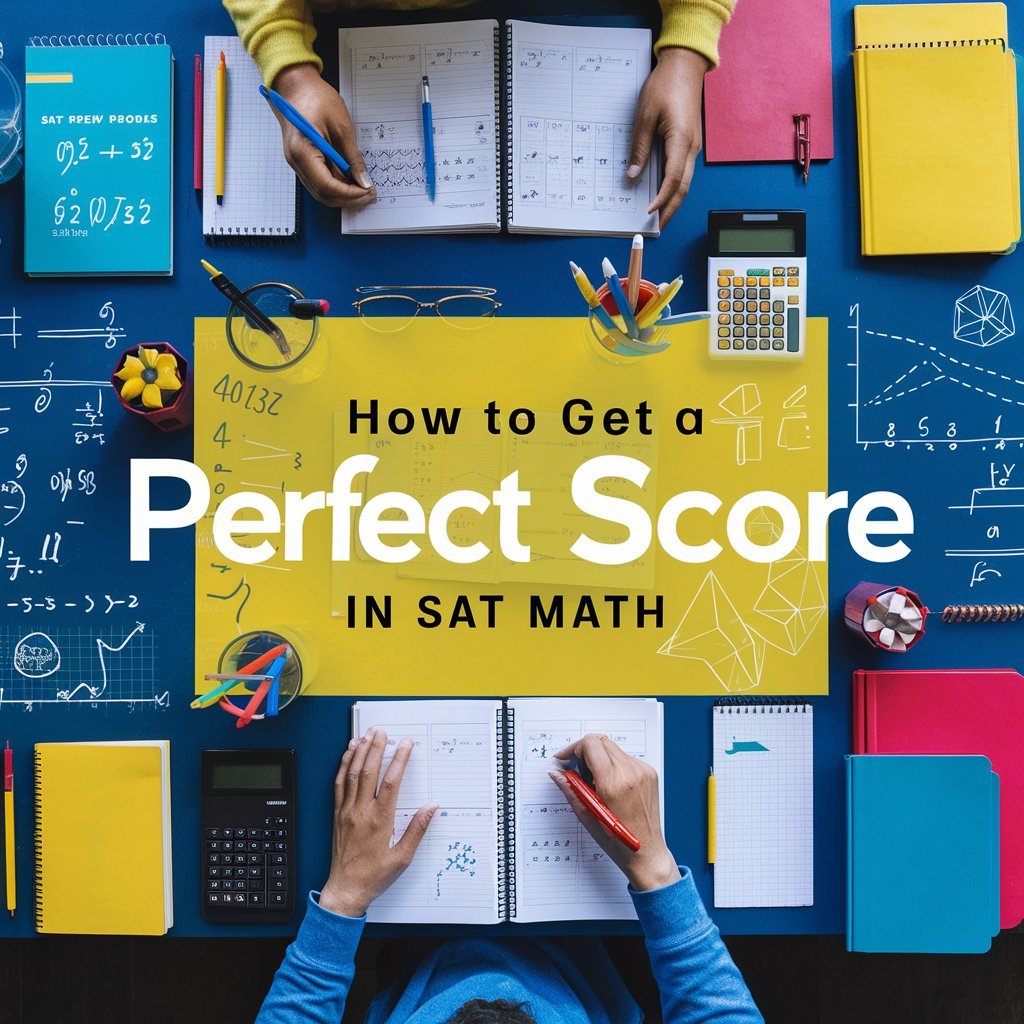- Introduction
- Importance of a Perfect Score
- Understanding the Digital SAT Math Section
- Strengthening Core Skills
- Resources and Materials
- How To Make The Most Out Of Desmos
- Practice, Practice, & Practice
- Mastering Test-Taking Strategies
- Common Mistakes to Avoid
- The Day Before the Test
- On Test Day
- Conclusion
- FAQs: Frequently Asked Questions
Introduction
The SAT Math section is a crucial component of the SAT exam, designed to assess a student’s mathematical abilities and readiness for college-level coursework. Achieving a perfect score in SAT Math not only demonstrates exceptional mathematical proficiency but also significantly enhances college applications, showcasing a student’s dedication, intelligence, and problem-solving skills.
Importance of a Perfect Score
- Competitive Edge in College Admissions: A perfect score in SAT Math sets a student apart from other applicants, highlighting their strong analytical and quantitative skills. This can be particularly advantageous when applying to top-tier universities, where competition is fierce.
- Scholarship Opportunities: Many scholarships and financial aid programs consider SAT scores as a part of their criteria. A perfect score in Math can increase the chances of securing scholarships, reducing the financial burden of college education.
- Foundation for STEM Majors: For students aspiring to pursue majors in science, technology, engineering, or mathematics (STEM), a perfect SAT Math score demonstrates their readiness for the rigorous coursework ahead. It serves as a strong indicator of their potential to excel in these fields.
- Personal Achievement and Confidence: Achieving a perfect score is a testament to a student’s hard work, dedication, and mastery of mathematical concepts. This accomplishment can boost their confidence and motivate them to tackle future academic and professional challenges with determination.
Understanding the Digital SAT Math Section
Structure and Format
The SAT Math portion is split into two sections:
- Module 1:
- Number of Questions: 22
- Time Allotted: 35 minutes
- Format: Multiple-choice and grid-in questions
- Module 2 (Adaptive):
- Number of Questions: 22
- Time Allotted: 35 minutes
- Format: Multiple-choice and grid-in questions
Topics Covered
- Algebra:
- Linear equations and inequalities
- Systems of equations
- Algebraic expressions and manipulation
- Problem Solving and Data Analysis:
- Ratios, proportions, and percentages
- Interpreting and analyzing data from tables, graphs, and charts
- Statistics and probability
- Advanced Math:
- Quadratic equations and functions
- Polynomial equations and functions
- Exponential and logarithmic relationships
- Radical and rational equations
- Geometry and Trigonometry:
- Properties of angles, triangles, circles, and polygons
- Area and volume calculations
- Trigonometric functions and identities
- Coordinate geometry and the distance formula
Strengthening Core Skills
- Practice Regularly:
- Consistent practice helps reinforce concepts and improves your ability to solve problems quickly and accurately. Utilize practice tests, workbooks, and online resources to stay engaged.
- Identify Weak Areas:
- Pay attention to the types of questions you struggle with and focus on improving those areas. Focused practice can transform weaknesses into strengths.
- Learn to Think Critically:
- Develop critical thinking skills by working through complex problems and exploring multiple solution paths. This will help you approach questions more effectively on test day.
- Work on Speed and Accuracy:
- Timed practice sessions can help you get used to the pace of the test. Aim to complete questions accurately within the allotted time to build both speed and confidence.
Resources and Materials
As this is a new format, it is important to refer to the appropriate resources for Digital SAT Practice tests.
Online Resources:
- Khan Academy: Provides complimentary, tailored SAT practice in collaboration with the College Board.
- SAT Prep Websites: You can prepare with Tutoring Maphy or other reliable websites for enhancing your SAT score.
Practice Books:
- The Princeton Review’s “Cracking the SAT”: Known for its comprehensive coverage and test-taking strategies.
- Barron’s SAT Math Workbook: Offers specific practice questions and thorough explanations to help you master mathematical concepts.
- The College Panda: Known for systematic categorization of questions.
The Princeton Review’s “Cracking the SAT” : Paperback or Download Now
Barron’s SAT Math Workbook : Paperback or Download Now
The College Panda: Paperback or Download Now
How To Make The Most Out Of Desmos
While many students may undervalue its importance, integrating Desmos into your study routine can significantly enhance your efficiency and understanding of complex mathematical concepts. Here’s how Desmos can be particularly beneficial:
1. Solving Complex Equations
When faced with challenging equations, such as solving two radical equations, Desmos can simplify the process. Instead of manually working through tedious algebraic manipulations, you can input the equations into Desmos and quickly find their intersection points. This feature not only conserves time but also diminishes the chance of errors in intricate calculations.
2. Finding Function Values at Any Point
Desmos excels at allowing users to find the values of functions at specific points effortlessly. By simply inputting the function and specifying the desired x-value, Desmos instantly provides the corresponding y-value. This is especially useful when dealing with piecewise functions or when you need to evaluate functions at multiple points quickly.

3. Visualizing and Solving Composite Functions
Composite functions can often be confusing and time-consuming to solve manually. Desmos enables you to visualize these functions by graphing each component separately and then combining them. This visual approach makes it easier to understand the behavior of composite functions and solve them accurately. You can overlay graphs, find intersections, and even animate transformations to get a deeper understanding.
4. Exploring Transformations and Graphical Behavior
Desmos provides an interactive platform to explore how different transformations affect the graph of a function. This is particularly useful for understanding shifts, stretches, and reflections. By manipulating parameters in real-time, you can gain a more intuitive grasp of how functions behave, which is invaluable for both understanding concepts and solving related questions on the SAT.

Apparently, making the most out of Desmos is the easiest way to increase SAT score.
Practice, Practice, & Practice
Importance of Practice Tests
- Familiarity with the Test Format:
- Taking practice tests helps you get accustomed to the structure, question types, and timing of the SAT Math section. This familiarity lowers anxiety and boosts confidence.
- Assessment of Progress:
- Regular practice tests provide a benchmark for measuring your improvement over time. They help you track your progress and determine whether your study strategies are effective.
- Identification of Weaknesses:
- Practice tests highlight the areas where you make mistakes or struggle the most. This allows you to focus your efforts on those specific topics, ensuring a more targeted and efficient study plan.
- Improvement of Test-Taking Skills:
- The more practice tests you take, the better you’ll become at managing your time, applying problem-solving techniques, and avoiding common pitfalls. This experience is invaluable for performing well on the actual test day.
How to Analyze Your Practice Test Results
- Review Every Question:
- Review each question, regardless of whether you answered it correctly or incorrectly.
- Identify Patterns:
- Look for patterns in your errors. Are there particular topics or question types that you repeatedly find challenging?
- Understand Your Mistakes:
- For each incorrect answer, determine the reason for the mistake. Was it due to a lack of knowledge, a miscalculation, a misunderstanding of the question, or an issue with time management?
- Take Notes:
- Create a log of your mistakes and the correct solutions. This will help you keep track of the concepts you need to revisit and reinforce your understanding.
Have you scored unevenly in your multiple SAT attempts? Super-scoring is the key! Check out What is Super-Score in SAT?
Time Management Strategies During Practice
- Practice Under Timed Conditions:
- Always take practice tests under timed conditions to simulate the actual test environment. This helps you develop a sense of pacing and ensures you can complete all questions in the given time.
- Set Time Limits for Each Question:
- Allocate a specific amount of time for each question (e.g., 1-2 minutes for easier questions and slightly longer for harder ones). If you exceed this time, move on and come back to the question later if time permits.
- Prioritize Easy Questions:
- Start with the questions you find easiest. This ensures you secure those points quickly and build confidence before tackling the more challenging questions.
- Skip and Return:
- If you encounter a particularly difficult question, skip it and move on to the next one. Go back to the skipped questions after finishing the rest of the section. This prevents you from spending too much time on a single problem.
- Keep an Eye on the Clock:
- Frequently monitor the time to make sure you’re staying on schedule. Divide the section into smaller time segments and aim to complete a certain number of questions within each segment.

Mastering Test-Taking Strategies
Approaching Multiple-Choice Questions
- Eliminate Wrong Answers:
- Utilize the process of elimination to reduce the answer options. Cross out options that are clearly incorrect to increase your chances of guessing correctly if needed.
- Look for Clues in the Answer Choices:
- Sometimes the answer choices themselves provide clues. For example, if the choices include both positive and negative numbers, consider the problem’s context to decide which is more likely correct.
- Work Backwards:
- For some questions, you can work backwards from the answer choices to the question. Substitute each choice into the problem to see which one works.
- Answer All Questions:
- There’s no penalty for incorrect answers on the SAT, so be sure to respond to every question. If you’re unsure, make an educated guess after eliminating as many incorrect options as possible.
- Manage Your Time:
- Allocate your time wisely. Allocate less time to easier questions and reserve more time for the challenging ones. Try to have a few minutes left at the end to review your responses.
Dealing with Grid-In Questions
- Understand the Format:
- Grid-in questions require you to generate your own answer without any provided answer choices. Familiarize yourself with the gridding process to avoid errors in transcription.
- Be Precise:
- Ensure your answers are precise and within the required format. For example, enter fractions as simplified forms and decimals accurately.
- Check Units and Format:
- Pay attention to units of measurement and whether the question asks for an answer in a specific format (e.g., nearest integer, decimal places).
- Double-Check Your Work:
- Since there are no answer choices to verify your response, double-check your calculations and ensure your answer makes sense in the context of the question.
- Use Estimation for Validation:
- Before gridding in your answer, use estimation to check if your calculated answer is reasonable. This helps catch any obvious errors.
- Practice Gridding:
- Practice using the grid-in format during your study sessions. This will help you become comfortable with the process and reduce the likelihood of mistakes on test day.
Common Mistakes to Avoid
Overcoming Common Pitfalls
- Misreading the Question:
- Solution: Read each question carefully, underlining or highlighting key information. Make sure you comprehend what is being asked before trying to solve it.
- Rushing Through Problems:
- Solution: Pace yourself by allocating a specific amount of time for each question. Prioritize accuracy over speed and remember to double-check your answers.
- Ignoring Units and Conversions:
- Solution: Always pay attention to the units provided in the question and ensure your answer is in the correct units. Practice unit conversion to avoid mistakes.
- Misinterpreting Graphs and Diagrams:
- Solution: Take your time to thoroughly examine graphs and diagrams. Focus on labels, scales, and legends to accurately understand the information provided.
Strategies for Avoiding Careless Errors
- Double-Check Calculations:
- Solution: After solving a problem, quickly recheck your calculations to ensure they are correct. Simple arithmetic errors can easily be avoided with a second look.
- Verify Your Answer:
- Solution: Cross-check your answer with the question to ensure it is logical within the context. Ask yourself if the answer is reasonable and fits the given information.
- Review Formulas:
- Solution: Regularly review and practice using Digital SAT key formulas. Knowing them well reduces the risk of applying the wrong formula or making calculation errors.
- Answer Every Question:
- Solution: Solution: Since there’s no penalty for guessing, make sure to answer every question, even if you’re uncertain. Use the process of elimination to make an educated guess if needed.
The Day Before the Test
Final Review Tips
- Review Key Concepts:
- Focus on reviewing key mathematical concepts and formulas that frequently appear on the SAT Math section. Use your study materials or notes for quick reference.
- Organize Your Materials:
- Gather all necessary materials for the test day, including identification, admission ticket, calculator (if allowed), pencils, erasers, and snacks.
What to Do
- Relax and Rest:
- Engage in activities that help you relax and unwind, such as light reading, listening to calming music, or practicing relaxation techniques.
- Eat a Balanced Meal:
- Have a nutritious dinner that includes lean proteins, whole grains, and vegetables. Steer clear of rich or unfamiliar foods that might upset your stomach.
What to Avoid
- Cramming:
- Avoid studying new material or trying to cram last-minute information. Focus instead on reinforcing what you’ve already learned.
- Staying Up Late:
- Aim to go to bed at a reasonable hour to ensure you get a full night’s sleep. Avoid screens (phones, tablets, computers) before bed to promote better sleep quality.
On Test Day
Essential Items to Bring
- Admission Ticket:
- Ensure you have your printed or digital SAT admission ticket with you for entry into the test center.
- Identification:
- Bring a valid photo ID (e.g., driver’s license, passport) that matches the name on your admission ticket.
- Calculator (if permitted):
- Check the College Board’s calculator policy to determine if your calculator model is allowed. Have fresh batteries or a backup calculator if needed.
- Pencils and Erasers:
- Bring several sharpened No. 2 pencils and erasers for filling in answer sheets and making corrections.
- Snacks and Water:
- Pack nutritious snacks (e.g., granola bars, fruit) and a bottle of water to stay hydrated and maintain energy levels during breaks.
- Watch (optional):
- A wristwatch to monitor time during the test, especially if you prefer not to rely solely on the room clock.
Staying Calm and Focused
- Controlled Breathing:
- Use deep breathing exercises to calm nerves and maintain focus. Take a deep breath in through your nose, hold it for a few seconds, and then exhale slowly through your mouth.
- Positive Self-Talk:
- Replace negative thoughts with positive affirmations. Remind yourself of your preparation and capabilities to tackle the test with confidence.
- Focus on the Task:
- Stay present and concentrate on one question at a time. Avoid thinking about previous questions or anticipating future ones.
- Manage Anxiety:
- If you feel anxious, take a moment to pause, close your eyes, and visualize a calming place or scenario. Repeat as needed to regain composure.
- Stay Hydrated and Nourished:
- Take sips of water and nibble on snacks during breaks to maintain hydration and energy levels without feeling distracted or jittery.
Wondering if SAT is optional, why bother? Here are 6 Reasons to take SAT even if it’s optional
Conclusion
Preparing for the SAT Math section requires dedication, strategic planning, and a focused approach to mastering both content and test-taking strategies. As you conclude your preparation journey, here’s a recap of key points to keep in mind and some final encouragement for test day.
Recap of Key Points
- Familiarize yourself with the structure, types of questions, and topics covered in the SAT Math section.
- Review and strengthen fundamental math concepts, particularly in algebra, geometry, and trigonometry
- Set realistic goals, create a study schedule, and utilize a variety of resources and practice tests to track your progress.
- Develop efficient problem-solving techniques, approach multiple-choice and grid-in questions strategically, and practice time management skills.
- Take advantage of recommended websites, apps, online courses, and practice test platforms to enhance your preparation.
- Maintain motivation through goal setting, positive reinforcement, and peer support. Build confidence through thorough preparation and effective management of test anxiety.
- Ensure you have all necessary items for test day, manage your time effectively during the exam, and stay calm and focused throughout each section.
FAQs: Frequently Asked Questions
Q. How can I get a perfect score in SAT Math?
To achieve a perfect score of 800 on the SAT Math section, follow these essential tips:
- Master the Content: Ensure you have a thorough understanding of all mathematical concepts tested on the SAT, including algebra, geometry, trigonometry, and advanced topics like functions and statistics.
- Practice Regularly: Use official SAT practice tests and reliable study resources to get accustomed to the test format and question types. Practice under timed conditions to enhance your speed and accuracy.
- Understand the SAT Math Format: Get to know the layout of the SAT Math section, including the types of questions (multiple-choice and grid-in) and the distribution of topics throughout the test.
- Develop Effective Strategies: Learn and apply strategic approaches for each question type, such as using the process of elimination in multiple-choice questions, managing time efficiently, and checking your work systematically.
- Utilize Resources: Take advantage of online resources, SAT prep courses, tutoring services, and study groups to reinforce learning and gain insights from experienced instructors.
- Stay Calm and Focused on Test Day: Manage test anxiety by practicing relaxation techniques, maintaining a positive mindset, and focusing on one question at a time during the exam.
Read further: Is Digital SAT easier than the pen-and-paper version?



